Business Operations, Functions and Customer Service Report
VerifiedAdded on 2020/06/03
|11
|2546
|63
Report
AI Summary
This report provides a comprehensive overview of business operations, encompassing the UK business environment, various organizational structures, and the impacts of local, national, and global economic factors on businesses like Sainsbury's. It delves into key business functions, including the importance of accounting, the roles of the HR department, and employment legislation. The report also explores team dynamics, including team development stages and motivational theories, alongside different leadership approaches. Furthermore, it examines the significance of customer service and its impact on business success, including the benefits of customer profiling. The report analyzes a profit and loss account and concludes with references, providing a well-rounded understanding of business operations and management.
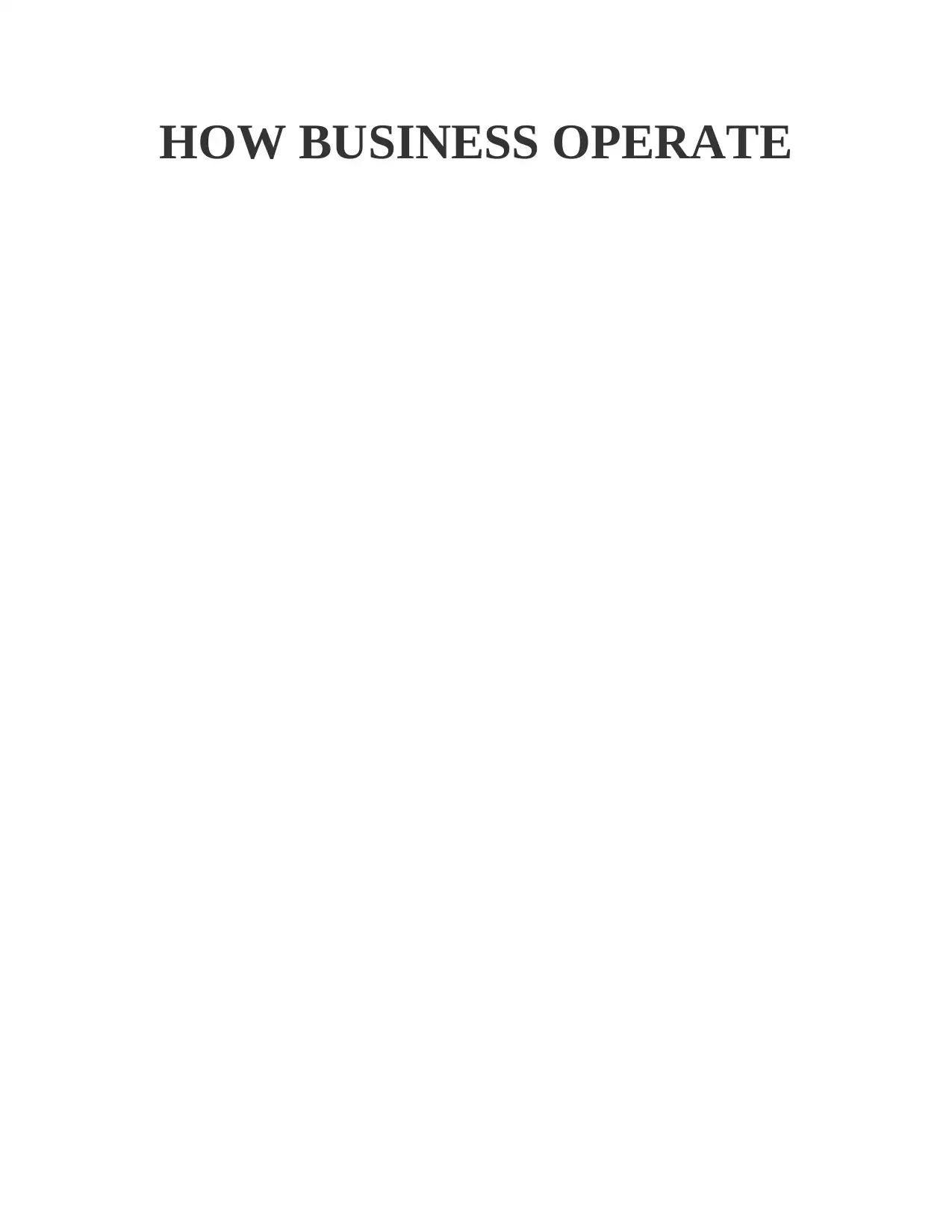
HOW BUSINESS OPERATE
Paraphrase This Document
Need a fresh take? Get an instant paraphrase of this document with our AI Paraphraser
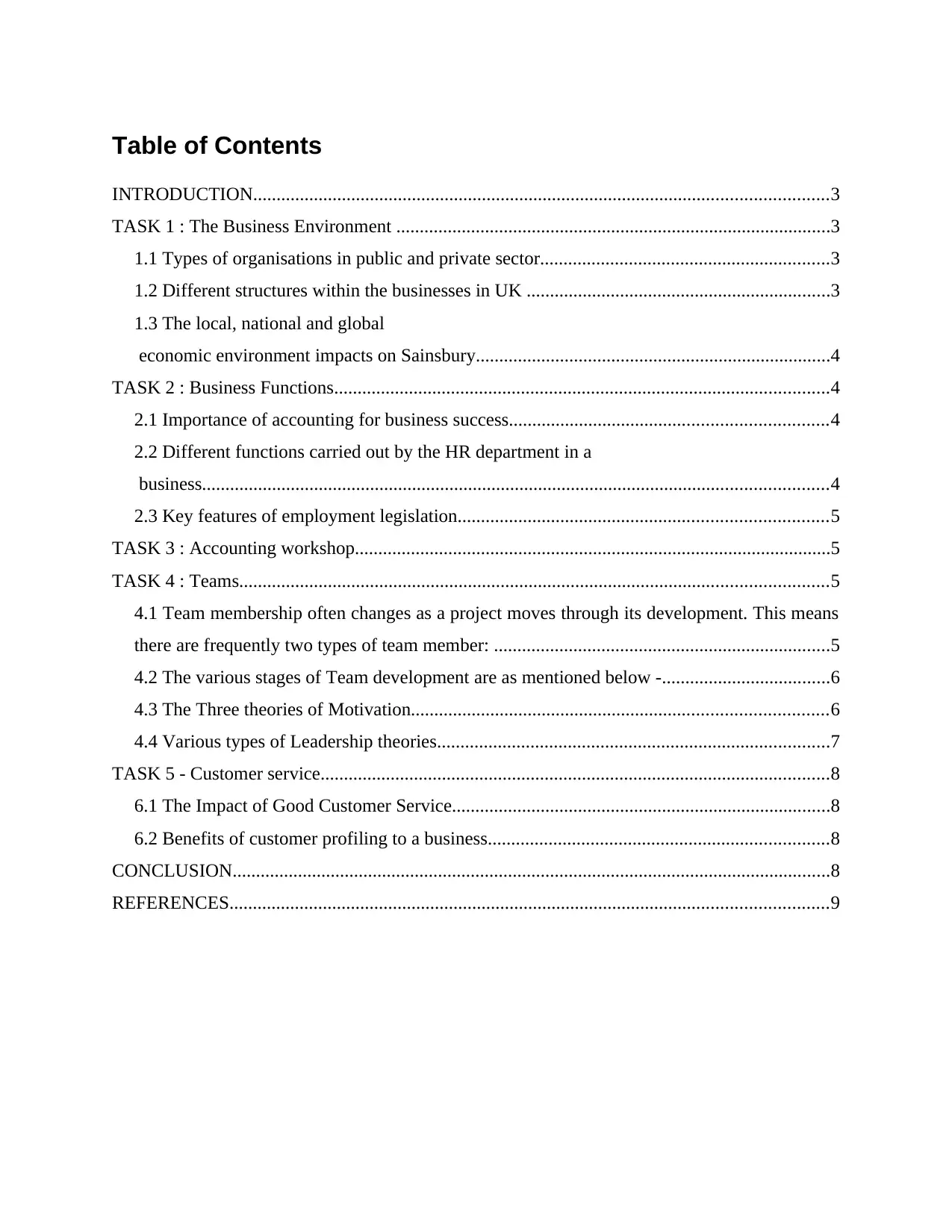
Table of Contents
INTRODUCTION...........................................................................................................................3
TASK 1 : The Business Environment .............................................................................................3
1.1 Types of organisations in public and private sector..............................................................3
1.2 Different structures within the businesses in UK .................................................................3
1.3 The local, national and global
economic environment impacts on Sainsbury............................................................................4
TASK 2 : Business Functions..........................................................................................................4
2.1 Importance of accounting for business success....................................................................4
2.2 Different functions carried out by the HR department in a
business......................................................................................................................................4
2.3 Key features of employment legislation...............................................................................5
TASK 3 : Accounting workshop......................................................................................................5
TASK 4 : Teams..............................................................................................................................5
4.1 Team membership often changes as a project moves through its development. This means
there are frequently two types of team member: ........................................................................5
4.2 The various stages of Team development are as mentioned below -....................................6
4.3 The Three theories of Motivation.........................................................................................6
4.4 Various types of Leadership theories....................................................................................7
TASK 5 - Customer service.............................................................................................................8
6.1 The Impact of Good Customer Service.................................................................................8
6.2 Benefits of customer profiling to a business.........................................................................8
CONCLUSION................................................................................................................................8
REFERENCES................................................................................................................................9
INTRODUCTION...........................................................................................................................3
TASK 1 : The Business Environment .............................................................................................3
1.1 Types of organisations in public and private sector..............................................................3
1.2 Different structures within the businesses in UK .................................................................3
1.3 The local, national and global
economic environment impacts on Sainsbury............................................................................4
TASK 2 : Business Functions..........................................................................................................4
2.1 Importance of accounting for business success....................................................................4
2.2 Different functions carried out by the HR department in a
business......................................................................................................................................4
2.3 Key features of employment legislation...............................................................................5
TASK 3 : Accounting workshop......................................................................................................5
TASK 4 : Teams..............................................................................................................................5
4.1 Team membership often changes as a project moves through its development. This means
there are frequently two types of team member: ........................................................................5
4.2 The various stages of Team development are as mentioned below -....................................6
4.3 The Three theories of Motivation.........................................................................................6
4.4 Various types of Leadership theories....................................................................................7
TASK 5 - Customer service.............................................................................................................8
6.1 The Impact of Good Customer Service.................................................................................8
6.2 Benefits of customer profiling to a business.........................................................................8
CONCLUSION................................................................................................................................8
REFERENCES................................................................................................................................9

INTRODUCTION
Operating a business is not an easy task, every organisation performs various functions
and techniques to achieve the organisation goal. Operations start as words on a piece of paper.
They are for all objectives and purpose essential to any business endeavour. At first, they are
inserted into the business plan to function as a rough roadmap. Both investors and founders can
easily access them and gain a better grasp on all the moving parts of a company, such as
personnel, equipment and the processes needed to increase the organization’s value.
This report will include various types of organisation in both public and private sector in the
UK. It will also describe the different structures in the businesses within the UK. The report will
also determine the local, national and global economic environment impacts on the business
operation of Sainsbury. This assignment will also identify the functions of various department in
an organisation or business such as Human resource department, accounting department etc.
Furthermore, the report will describe the various impact of customer service on success of a
business along with the benefits of customer service for a business or organisation.
TASK 1 : The Business Environment
1.1 Types of organisations in public and private sector
There are many types of organisation in public and private sector in the UK, these
organisations are as mentioned below -
Sole trader – A sole trader is a most common type of business ownership and can be
found in various type of activities such as plumbing, cleaning etc. The sole trader makes
every decisions him or herself.
Partnership – A partnership business is set by two or more individuals who collaborate
together to achieve a same business goal. Partnerships are generally created by writing a
partnership deed having al the details of profit and loss share.
Company – A company is a legalised body in its own right with an existence that is
separate in laws form the owners
Franchise – A Franchise is grants permission to sell a product or service and trade under a
specific name in a certain area.
1.2 Different structures within the businesses in UK
The structure of a business or organisation depends on the project or company. The main
reason for various types of structures in organisations is to define the responsibilities and roles of
Operating a business is not an easy task, every organisation performs various functions
and techniques to achieve the organisation goal. Operations start as words on a piece of paper.
They are for all objectives and purpose essential to any business endeavour. At first, they are
inserted into the business plan to function as a rough roadmap. Both investors and founders can
easily access them and gain a better grasp on all the moving parts of a company, such as
personnel, equipment and the processes needed to increase the organization’s value.
This report will include various types of organisation in both public and private sector in the
UK. It will also describe the different structures in the businesses within the UK. The report will
also determine the local, national and global economic environment impacts on the business
operation of Sainsbury. This assignment will also identify the functions of various department in
an organisation or business such as Human resource department, accounting department etc.
Furthermore, the report will describe the various impact of customer service on success of a
business along with the benefits of customer service for a business or organisation.
TASK 1 : The Business Environment
1.1 Types of organisations in public and private sector
There are many types of organisation in public and private sector in the UK, these
organisations are as mentioned below -
Sole trader – A sole trader is a most common type of business ownership and can be
found in various type of activities such as plumbing, cleaning etc. The sole trader makes
every decisions him or herself.
Partnership – A partnership business is set by two or more individuals who collaborate
together to achieve a same business goal. Partnerships are generally created by writing a
partnership deed having al the details of profit and loss share.
Company – A company is a legalised body in its own right with an existence that is
separate in laws form the owners
Franchise – A Franchise is grants permission to sell a product or service and trade under a
specific name in a certain area.
1.2 Different structures within the businesses in UK
The structure of a business or organisation depends on the project or company. The main
reason for various types of structures in organisations is to define the responsibilities and roles of
⊘ This is a preview!⊘
Do you want full access?
Subscribe today to unlock all pages.

Trusted by 1+ million students worldwide
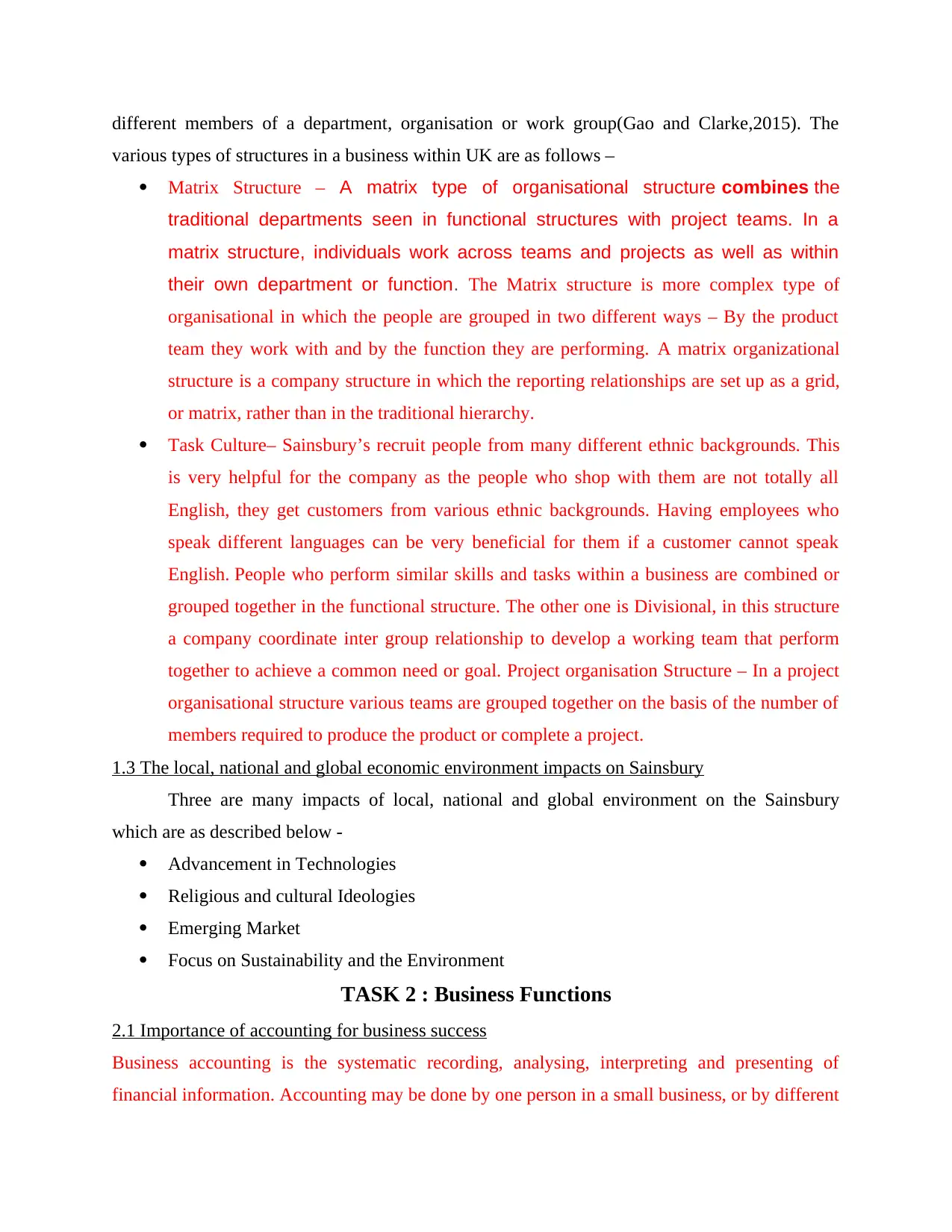
different members of a department, organisation or work group(Gao and Clarke,2015). The
various types of structures in a business within UK are as follows –
Matrix Structure – A matrix type of organisational structure combines the
traditional departments seen in functional structures with project teams. In a
matrix structure, individuals work across teams and projects as well as within
their own department or function. The Matrix structure is more complex type of
organisational in which the people are grouped in two different ways – By the product
team they work with and by the function they are performing. A matrix organizational
structure is a company structure in which the reporting relationships are set up as a grid,
or matrix, rather than in the traditional hierarchy.
Task Culture– Sainsbury’s recruit people from many different ethnic backgrounds. This
is very helpful for the company as the people who shop with them are not totally all
English, they get customers from various ethnic backgrounds. Having employees who
speak different languages can be very beneficial for them if a customer cannot speak
English. People who perform similar skills and tasks within a business are combined or
grouped together in the functional structure. The other one is Divisional, in this structure
a company coordinate inter group relationship to develop a working team that perform
together to achieve a common need or goal. Project organisation Structure – In a project
organisational structure various teams are grouped together on the basis of the number of
members required to produce the product or complete a project.
1.3 The local, national and global economic environment impacts on Sainsbury
Three are many impacts of local, national and global environment on the Sainsbury
which are as described below -
Advancement in Technologies
Religious and cultural Ideologies
Emerging Market
Focus on Sustainability and the Environment
TASK 2 : Business Functions
2.1 Importance of accounting for business success
Business accounting is the systematic recording, analysing, interpreting and presenting of
financial information. Accounting may be done by one person in a small business, or by different
various types of structures in a business within UK are as follows –
Matrix Structure – A matrix type of organisational structure combines the
traditional departments seen in functional structures with project teams. In a
matrix structure, individuals work across teams and projects as well as within
their own department or function. The Matrix structure is more complex type of
organisational in which the people are grouped in two different ways – By the product
team they work with and by the function they are performing. A matrix organizational
structure is a company structure in which the reporting relationships are set up as a grid,
or matrix, rather than in the traditional hierarchy.
Task Culture– Sainsbury’s recruit people from many different ethnic backgrounds. This
is very helpful for the company as the people who shop with them are not totally all
English, they get customers from various ethnic backgrounds. Having employees who
speak different languages can be very beneficial for them if a customer cannot speak
English. People who perform similar skills and tasks within a business are combined or
grouped together in the functional structure. The other one is Divisional, in this structure
a company coordinate inter group relationship to develop a working team that perform
together to achieve a common need or goal. Project organisation Structure – In a project
organisational structure various teams are grouped together on the basis of the number of
members required to produce the product or complete a project.
1.3 The local, national and global economic environment impacts on Sainsbury
Three are many impacts of local, national and global environment on the Sainsbury
which are as described below -
Advancement in Technologies
Religious and cultural Ideologies
Emerging Market
Focus on Sustainability and the Environment
TASK 2 : Business Functions
2.1 Importance of accounting for business success
Business accounting is the systematic recording, analysing, interpreting and presenting of
financial information. Accounting may be done by one person in a small business, or by different
Paraphrase This Document
Need a fresh take? Get an instant paraphrase of this document with our AI Paraphraser
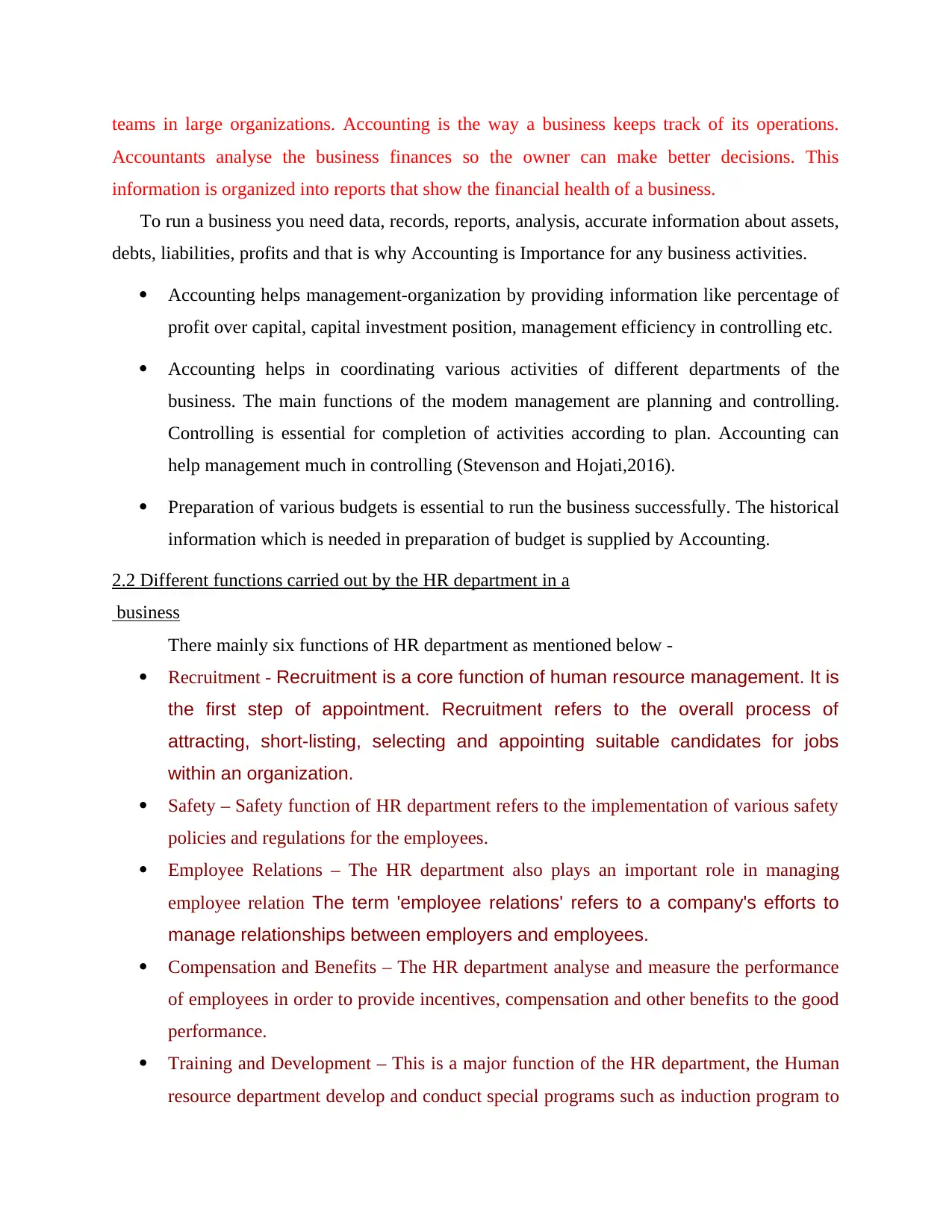
teams in large organizations. Accounting is the way a business keeps track of its operations.
Accountants analyse the business finances so the owner can make better decisions. This
information is organized into reports that show the financial health of a business.
To run a business you need data, records, reports, analysis, accurate information about assets,
debts, liabilities, profits and that is why Accounting is Importance for any business activities.
Accounting helps management-organization by providing information like percentage of
profit over capital, capital investment position, management efficiency in controlling etc.
Accounting helps in coordinating various activities of different departments of the
business. The main functions of the modem management are planning and controlling.
Controlling is essential for completion of activities according to plan. Accounting can
help management much in controlling (Stevenson and Hojati,2016).
Preparation of various budgets is essential to run the business successfully. The historical
information which is needed in preparation of budget is supplied by Accounting.
2.2 Different functions carried out by the HR department in a
business
There mainly six functions of HR department as mentioned below -
Recruitment - Recruitment is a core function of human resource management. It is
the first step of appointment. Recruitment refers to the overall process of
attracting, short-listing, selecting and appointing suitable candidates for jobs
within an organization.
Safety – Safety function of HR department refers to the implementation of various safety
policies and regulations for the employees.
Employee Relations – The HR department also plays an important role in managing
employee relation The term 'employee relations' refers to a company's efforts to
manage relationships between employers and employees.
Compensation and Benefits – The HR department analyse and measure the performance
of employees in order to provide incentives, compensation and other benefits to the good
performance.
Training and Development – This is a major function of the HR department, the Human
resource department develop and conduct special programs such as induction program to
Accountants analyse the business finances so the owner can make better decisions. This
information is organized into reports that show the financial health of a business.
To run a business you need data, records, reports, analysis, accurate information about assets,
debts, liabilities, profits and that is why Accounting is Importance for any business activities.
Accounting helps management-organization by providing information like percentage of
profit over capital, capital investment position, management efficiency in controlling etc.
Accounting helps in coordinating various activities of different departments of the
business. The main functions of the modem management are planning and controlling.
Controlling is essential for completion of activities according to plan. Accounting can
help management much in controlling (Stevenson and Hojati,2016).
Preparation of various budgets is essential to run the business successfully. The historical
information which is needed in preparation of budget is supplied by Accounting.
2.2 Different functions carried out by the HR department in a
business
There mainly six functions of HR department as mentioned below -
Recruitment - Recruitment is a core function of human resource management. It is
the first step of appointment. Recruitment refers to the overall process of
attracting, short-listing, selecting and appointing suitable candidates for jobs
within an organization.
Safety – Safety function of HR department refers to the implementation of various safety
policies and regulations for the employees.
Employee Relations – The HR department also plays an important role in managing
employee relation The term 'employee relations' refers to a company's efforts to
manage relationships between employers and employees.
Compensation and Benefits – The HR department analyse and measure the performance
of employees in order to provide incentives, compensation and other benefits to the good
performance.
Training and Development – This is a major function of the HR department, the Human
resource department develop and conduct special programs such as induction program to
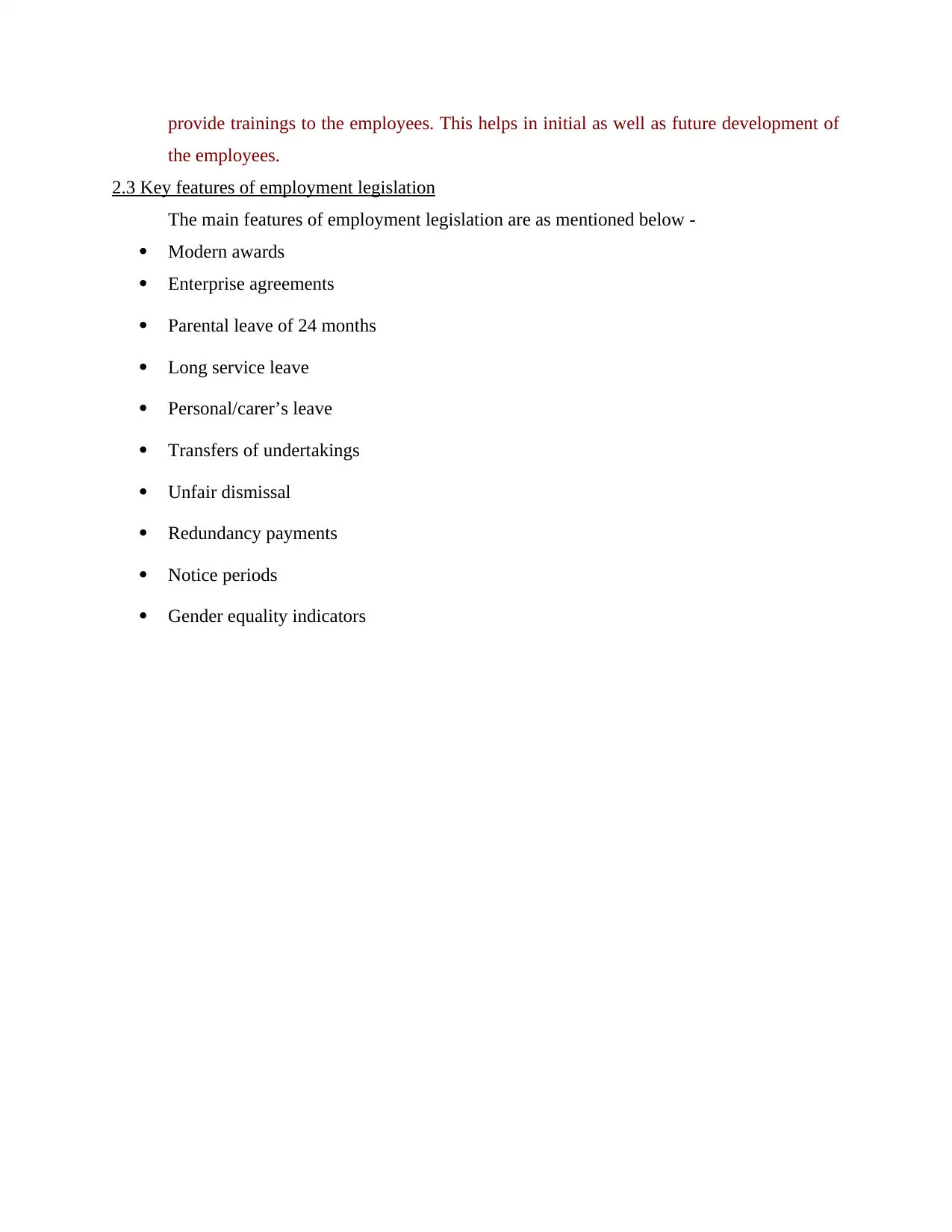
provide trainings to the employees. This helps in initial as well as future development of
the employees.
2.3 Key features of employment legislation
The main features of employment legislation are as mentioned below -
Modern awards
Enterprise agreements
Parental leave of 24 months
Long service leave
Personal/carer’s leave
Transfers of undertakings
Unfair dismissal
Redundancy payments
Notice periods
Gender equality indicators
the employees.
2.3 Key features of employment legislation
The main features of employment legislation are as mentioned below -
Modern awards
Enterprise agreements
Parental leave of 24 months
Long service leave
Personal/carer’s leave
Transfers of undertakings
Unfair dismissal
Redundancy payments
Notice periods
Gender equality indicators
⊘ This is a preview!⊘
Do you want full access?
Subscribe today to unlock all pages.

Trusted by 1+ million students worldwide
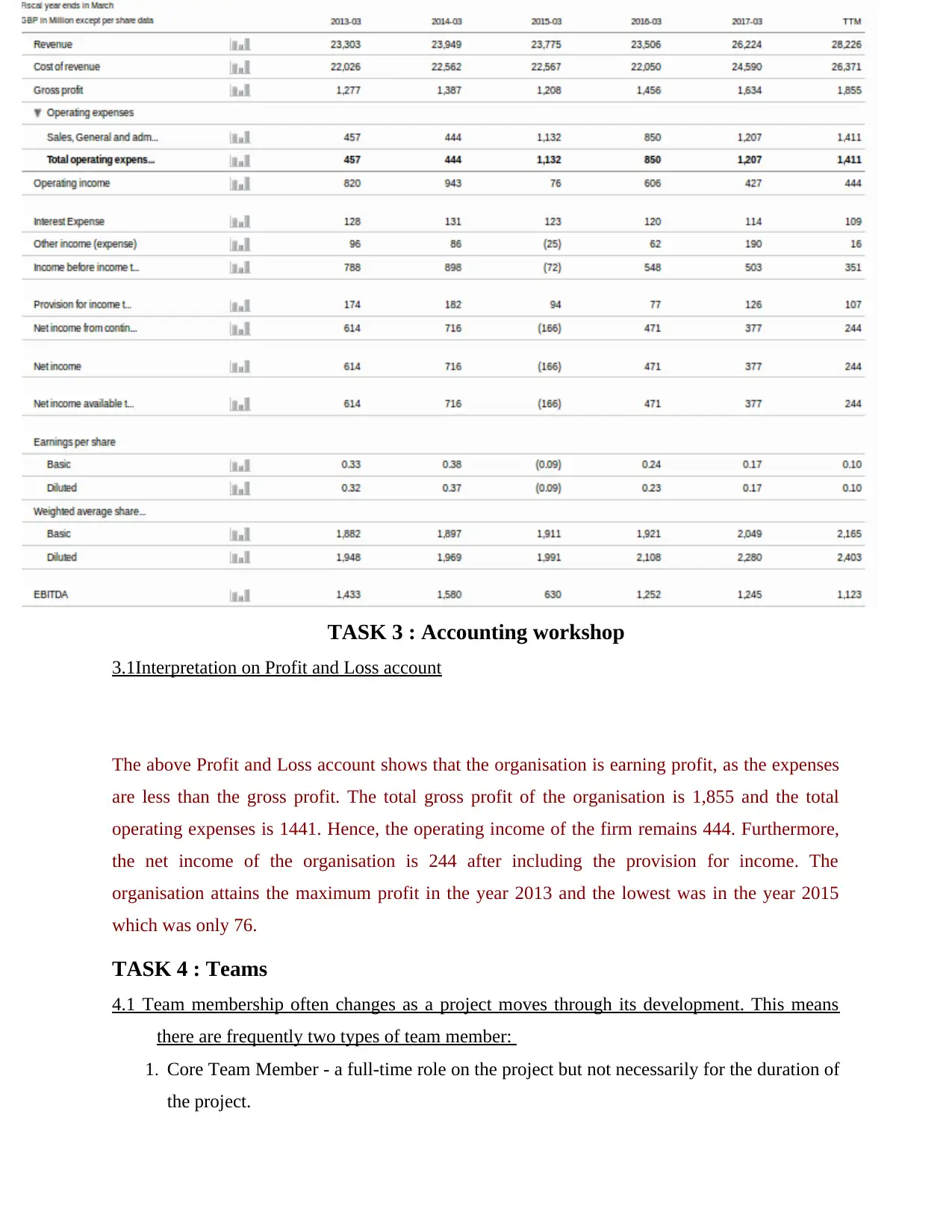
TASK 3 : Accounting workshop
3.1Interpretation on Profit and Loss account
The above Profit and Loss account shows that the organisation is earning profit, as the expenses
are less than the gross profit. The total gross profit of the organisation is 1,855 and the total
operating expenses is 1441. Hence, the operating income of the firm remains 444. Furthermore,
the net income of the organisation is 244 after including the provision for income. The
organisation attains the maximum profit in the year 2013 and the lowest was in the year 2015
which was only 76.
TASK 4 : Teams
4.1 Team membership often changes as a project moves through its development. This means
there are frequently two types of team member:
1. Core Team Member - a full-time role on the project but not necessarily for the duration of
the project.
3.1Interpretation on Profit and Loss account
The above Profit and Loss account shows that the organisation is earning profit, as the expenses
are less than the gross profit. The total gross profit of the organisation is 1,855 and the total
operating expenses is 1441. Hence, the operating income of the firm remains 444. Furthermore,
the net income of the organisation is 244 after including the provision for income. The
organisation attains the maximum profit in the year 2013 and the lowest was in the year 2015
which was only 76.
TASK 4 : Teams
4.1 Team membership often changes as a project moves through its development. This means
there are frequently two types of team member:
1. Core Team Member - a full-time role on the project but not necessarily for the duration of
the project.
Paraphrase This Document
Need a fresh take? Get an instant paraphrase of this document with our AI Paraphraser

2. Extended Team Member - a part-time role on the project. These team members will
usually have their regular job to do, or they may be from an outside company(Hill,2016).
My Responsibilities in the Team
Understanding the purpose and objectives of the project
ensuring a correct balance between project and non-project work
working to time-scales and within cost constraints
reporting progress against plan
producing the deliverables/products to agreed specifications
reviewing key project deliverables/products
4.2 The various stages of Team development are as mentioned below -
Forming
Storming
Norming
Performing Stage
Adjourning Stage
Groups are so in-sync during the performing stage that it seems to happen naturally. But, don’t
be fooled. The most effective and high-functioning teams are cultivated. Throwing a group of
talented people together doesn’t mean that they will form a great team. Hoping that your
company or project will be a success won’t make it happen. Understanding Tuckman’s
development process can increase your chances of reaching project goals.
4.3 The Three theories of Motivation
Hertzberg’s Two-Factor Theory
Motivator factors – Simply put, these are factors that lead to satisfaction and motivate
employees to work harder. Examples might include enjoying your work, feeling
recognised and career progression.
Hygiene factors – These factors can lead to dissatisfaction and a lack of motivation if
they are absent. Examples include salary, company policies, benefits, relationships with
managers and co-workers.
usually have their regular job to do, or they may be from an outside company(Hill,2016).
My Responsibilities in the Team
Understanding the purpose and objectives of the project
ensuring a correct balance between project and non-project work
working to time-scales and within cost constraints
reporting progress against plan
producing the deliverables/products to agreed specifications
reviewing key project deliverables/products
4.2 The various stages of Team development are as mentioned below -
Forming
Storming
Norming
Performing Stage
Adjourning Stage
Groups are so in-sync during the performing stage that it seems to happen naturally. But, don’t
be fooled. The most effective and high-functioning teams are cultivated. Throwing a group of
talented people together doesn’t mean that they will form a great team. Hoping that your
company or project will be a success won’t make it happen. Understanding Tuckman’s
development process can increase your chances of reaching project goals.
4.3 The Three theories of Motivation
Hertzberg’s Two-Factor Theory
Motivator factors – Simply put, these are factors that lead to satisfaction and motivate
employees to work harder. Examples might include enjoying your work, feeling
recognised and career progression.
Hygiene factors – These factors can lead to dissatisfaction and a lack of motivation if
they are absent. Examples include salary, company policies, benefits, relationships with
managers and co-workers.
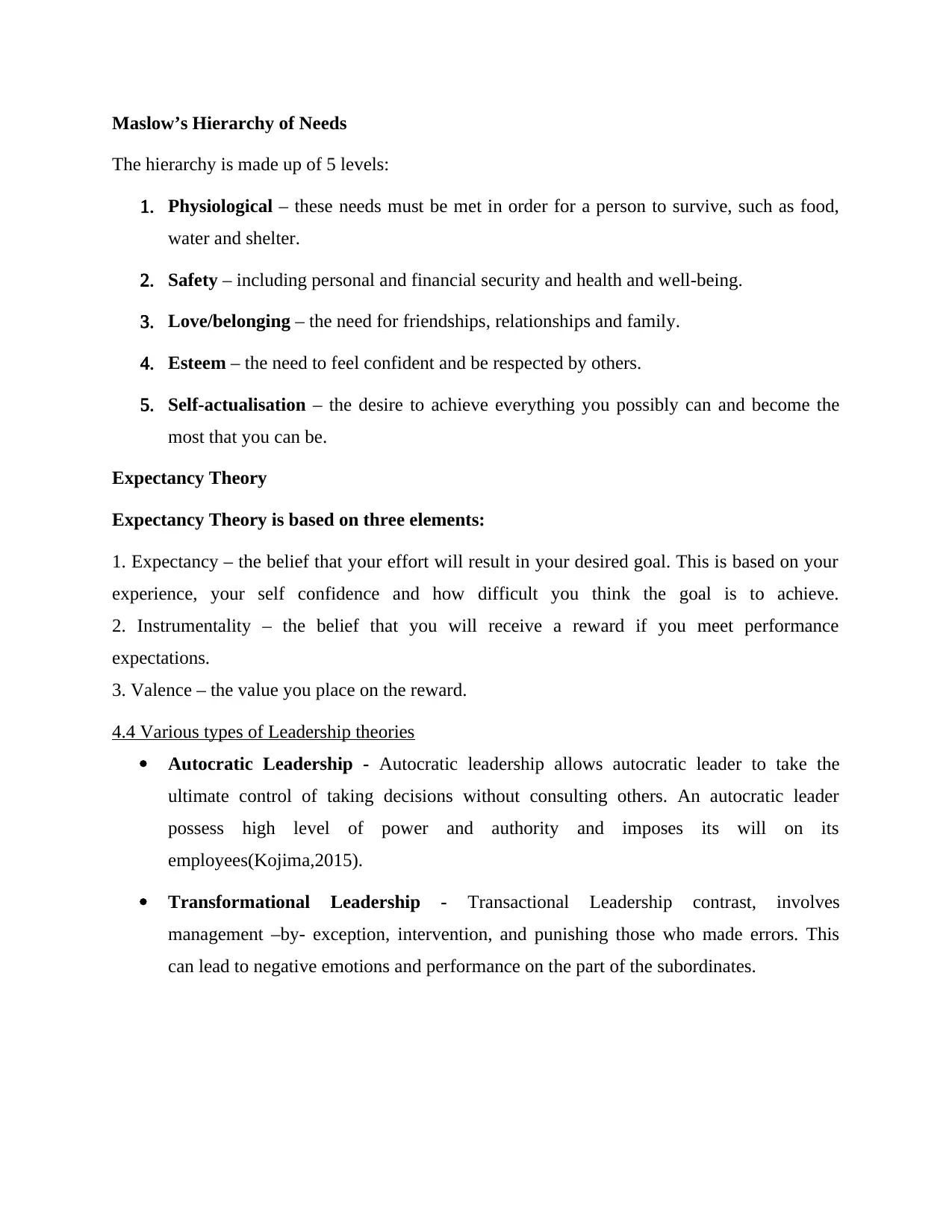
Maslow’s Hierarchy of Needs
The hierarchy is made up of 5 levels:
1. Physiological – these needs must be met in order for a person to survive, such as food,
water and shelter.
2. Safety – including personal and financial security and health and well-being.
3. Love/belonging – the need for friendships, relationships and family.
4. Esteem – the need to feel confident and be respected by others.
5. Self-actualisation – the desire to achieve everything you possibly can and become the
most that you can be.
Expectancy Theory
Expectancy Theory is based on three elements:
1. Expectancy – the belief that your effort will result in your desired goal. This is based on your
experience, your self confidence and how difficult you think the goal is to achieve.
2. Instrumentality – the belief that you will receive a reward if you meet performance
expectations.
3. Valence – the value you place on the reward.
4.4 Various types of Leadership theories
Autocratic Leadership - Autocratic leadership allows autocratic leader to take the
ultimate control of taking decisions without consulting others. An autocratic leader
possess high level of power and authority and imposes its will on its
employees(Kojima,2015).
Transformational Leadership - Transactional Leadership contrast, involves
management –by- exception, intervention, and punishing those who made errors. This
can lead to negative emotions and performance on the part of the subordinates.
The hierarchy is made up of 5 levels:
1. Physiological – these needs must be met in order for a person to survive, such as food,
water and shelter.
2. Safety – including personal and financial security and health and well-being.
3. Love/belonging – the need for friendships, relationships and family.
4. Esteem – the need to feel confident and be respected by others.
5. Self-actualisation – the desire to achieve everything you possibly can and become the
most that you can be.
Expectancy Theory
Expectancy Theory is based on three elements:
1. Expectancy – the belief that your effort will result in your desired goal. This is based on your
experience, your self confidence and how difficult you think the goal is to achieve.
2. Instrumentality – the belief that you will receive a reward if you meet performance
expectations.
3. Valence – the value you place on the reward.
4.4 Various types of Leadership theories
Autocratic Leadership - Autocratic leadership allows autocratic leader to take the
ultimate control of taking decisions without consulting others. An autocratic leader
possess high level of power and authority and imposes its will on its
employees(Kojima,2015).
Transformational Leadership - Transactional Leadership contrast, involves
management –by- exception, intervention, and punishing those who made errors. This
can lead to negative emotions and performance on the part of the subordinates.
⊘ This is a preview!⊘
Do you want full access?
Subscribe today to unlock all pages.

Trusted by 1+ million students worldwide
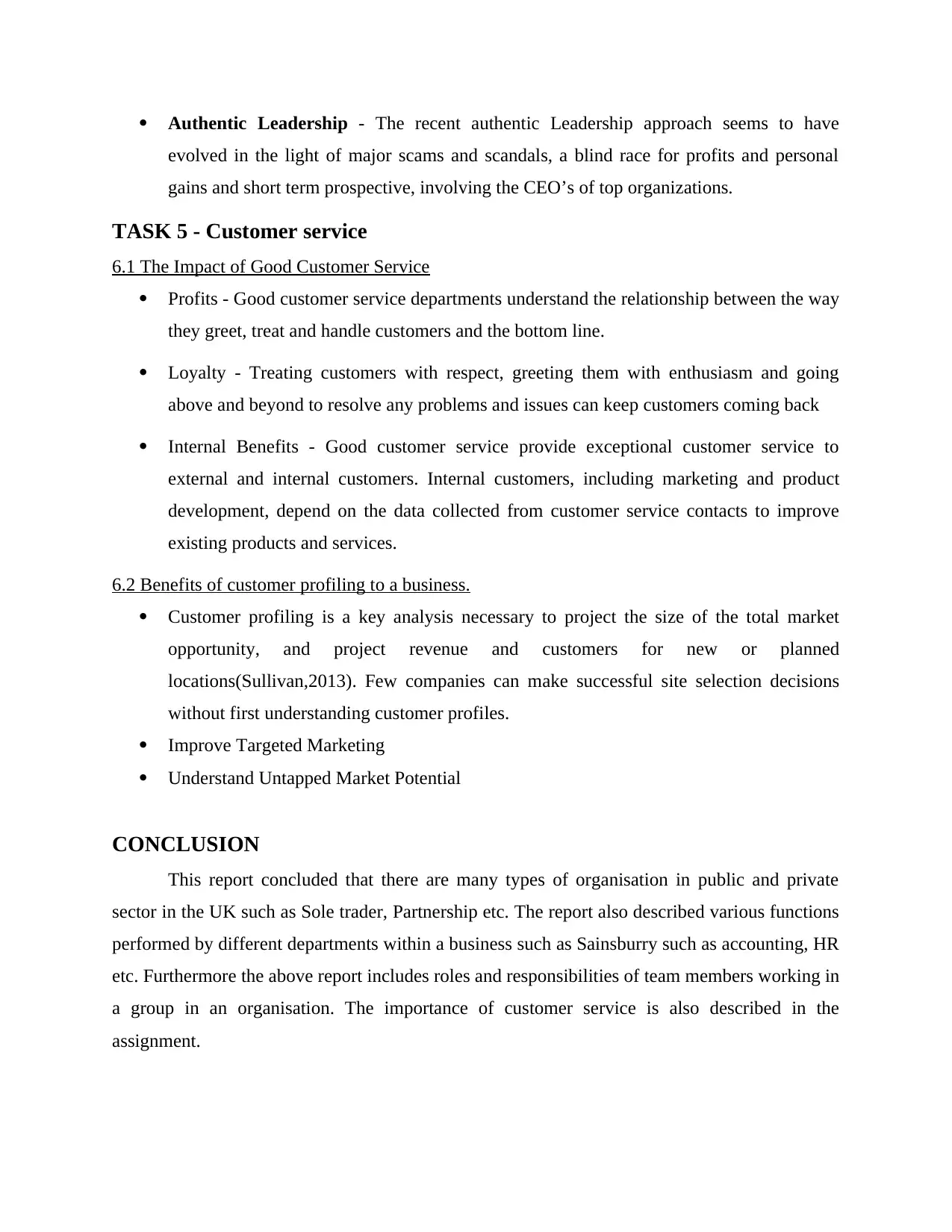
Authentic Leadership - The recent authentic Leadership approach seems to have
evolved in the light of major scams and scandals, a blind race for profits and personal
gains and short term prospective, involving the CEO’s of top organizations.
TASK 5 - Customer service
6.1 The Impact of Good Customer Service
Profits - Good customer service departments understand the relationship between the way
they greet, treat and handle customers and the bottom line.
Loyalty - Treating customers with respect, greeting them with enthusiasm and going
above and beyond to resolve any problems and issues can keep customers coming back
Internal Benefits - Good customer service provide exceptional customer service to
external and internal customers. Internal customers, including marketing and product
development, depend on the data collected from customer service contacts to improve
existing products and services.
6.2 Benefits of customer profiling to a business.
Customer profiling is a key analysis necessary to project the size of the total market
opportunity, and project revenue and customers for new or planned
locations(Sullivan,2013). Few companies can make successful site selection decisions
without first understanding customer profiles.
Improve Targeted Marketing
Understand Untapped Market Potential
CONCLUSION
This report concluded that there are many types of organisation in public and private
sector in the UK such as Sole trader, Partnership etc. The report also described various functions
performed by different departments within a business such as Sainsburry such as accounting, HR
etc. Furthermore the above report includes roles and responsibilities of team members working in
a group in an organisation. The importance of customer service is also described in the
assignment.
evolved in the light of major scams and scandals, a blind race for profits and personal
gains and short term prospective, involving the CEO’s of top organizations.
TASK 5 - Customer service
6.1 The Impact of Good Customer Service
Profits - Good customer service departments understand the relationship between the way
they greet, treat and handle customers and the bottom line.
Loyalty - Treating customers with respect, greeting them with enthusiasm and going
above and beyond to resolve any problems and issues can keep customers coming back
Internal Benefits - Good customer service provide exceptional customer service to
external and internal customers. Internal customers, including marketing and product
development, depend on the data collected from customer service contacts to improve
existing products and services.
6.2 Benefits of customer profiling to a business.
Customer profiling is a key analysis necessary to project the size of the total market
opportunity, and project revenue and customers for new or planned
locations(Sullivan,2013). Few companies can make successful site selection decisions
without first understanding customer profiles.
Improve Targeted Marketing
Understand Untapped Market Potential
CONCLUSION
This report concluded that there are many types of organisation in public and private
sector in the UK such as Sole trader, Partnership etc. The report also described various functions
performed by different departments within a business such as Sainsburry such as accounting, HR
etc. Furthermore the above report includes roles and responsibilities of team members working in
a group in an organisation. The importance of customer service is also described in the
assignment.
Paraphrase This Document
Need a fresh take? Get an instant paraphrase of this document with our AI Paraphraser
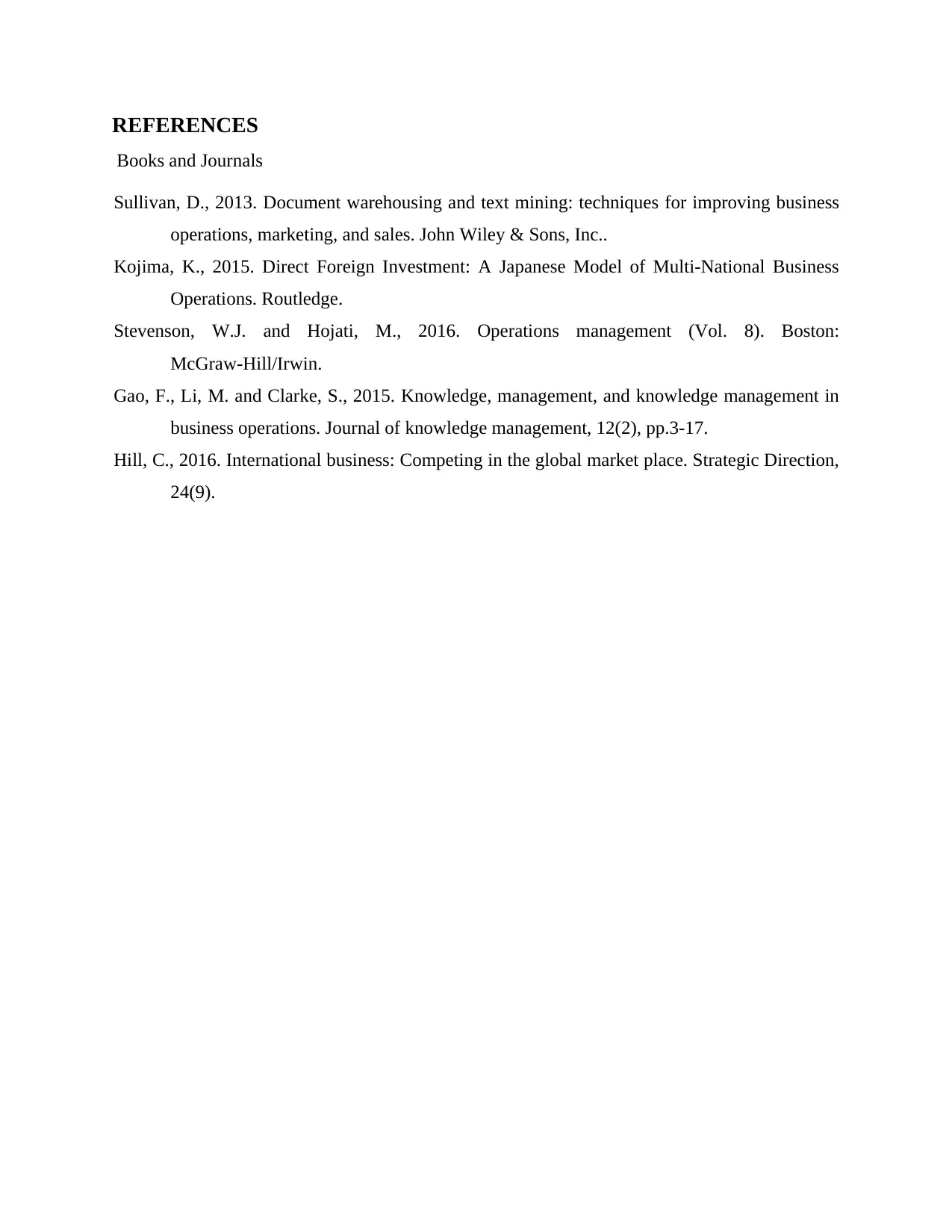
REFERENCES
Books and Journals
Sullivan, D., 2013. Document warehousing and text mining: techniques for improving business
operations, marketing, and sales. John Wiley & Sons, Inc..
Kojima, K., 2015. Direct Foreign Investment: A Japanese Model of Multi-National Business
Operations. Routledge.
Stevenson, W.J. and Hojati, M., 2016. Operations management (Vol. 8). Boston:
McGraw-Hill/Irwin.
Gao, F., Li, M. and Clarke, S., 2015. Knowledge, management, and knowledge management in
business operations. Journal of knowledge management, 12(2), pp.3-17.
Hill, C., 2016. International business: Competing in the global market place. Strategic Direction,
24(9).
Books and Journals
Sullivan, D., 2013. Document warehousing and text mining: techniques for improving business
operations, marketing, and sales. John Wiley & Sons, Inc..
Kojima, K., 2015. Direct Foreign Investment: A Japanese Model of Multi-National Business
Operations. Routledge.
Stevenson, W.J. and Hojati, M., 2016. Operations management (Vol. 8). Boston:
McGraw-Hill/Irwin.
Gao, F., Li, M. and Clarke, S., 2015. Knowledge, management, and knowledge management in
business operations. Journal of knowledge management, 12(2), pp.3-17.
Hill, C., 2016. International business: Competing in the global market place. Strategic Direction,
24(9).
1 out of 11
Related Documents
Your All-in-One AI-Powered Toolkit for Academic Success.
+13062052269
info@desklib.com
Available 24*7 on WhatsApp / Email
![[object Object]](/_next/static/media/star-bottom.7253800d.svg)
Unlock your academic potential
Copyright © 2020–2025 A2Z Services. All Rights Reserved. Developed and managed by ZUCOL.




